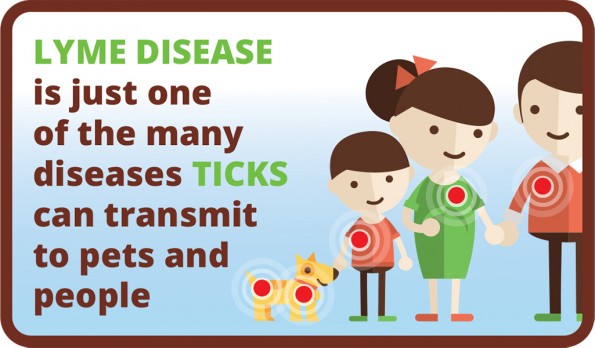
TICKS AND LYME DISEASE
Lyme disease is something that isn’t really on our radar as far as a typical disease that our pets can get, but since we have experienced a boom in the tick population in our area, it’s something that we are starting to see more and more of. Lyme disease is the most well publicizes disease that these guys transmit, but they can also spread other very deadly diseases such as Anaplasmosis, Erlichiosis, and Babesiosis. Although these guys get less press than Lyme does, they can still wreak havoc on us and our pets!
Lyme disease is spread by Ticks (specifically the Deer Tick/Blacklegged Tick or “Ixodes Scapularis” if you want to be scientific) and it’s a disease that can cause a lot of pain and discomfort in our pets. It also turns out that humans can get Lyme disease as well, so if our pets are at risk, it’s important to remember that our human family members are at risk too. In our pets Lyme disease can cause painful joints, fever, kidney failure, and in some cases heart disease and neurologic disease. It is very painful and it can be fatal in some cases if left untreated.
Lyme disease itself is a bacteria that the ticks carry with them and transmit to whichever animal they decide to feed off of. They will crawl around on their host animal, decide that they are hungry, bury their mouth parts under the skin, and begin taking a blood meal from their host. It’s after this bite that we need to worry about the transmission of Lyme disease. Generally a tick has to be feeding for at least 24 hours for them to transmit Lyme disease.
Our pets can come into contact with these little blood suckers anywhere where wildlife lives, and that INCLUDES our back yards, on the street on walks, on hiking trails, etc. Anywhere where a bird, squirrel, raccoon or a mouse can be, ticks can also be found as these are the creatures that the tick needs to complete its life cycle. Generally a tick will feed on several different hosts. After each blood meal the tick will fall off one host, molt into its next form, and then be ready to jump onto the next host to do it all over again. Each time they do this they can transmit Lyme disease if they are infected, and the Deer tick will complete this cycle 3 times before they reach adult form and are ready to mate and lay eggs.
You may be thinking “well how could I possibly not notice a tick feeding off of myself or my pet if they need to be stuck on for 24 hours before Lyme disease is transmitted?” and the answer to this is that these guys are generally painless, stealthy, and they can be extremely small in their young nymph form. This means that you may well NOT see them on yourself or your pet and they will be there, feed, and fall off before you know it!
Above is a picture to show you just how small these guys can be!
One of the most important things for us as pet owners and family members to do is actively PREVENT our animals from getting ticks and potentially Lyme disease. Remember, when that tick falls off your pet they will be looking for another host for their next blood meal, and that next host could be a human family member!
We have excellent medications to give our pets now to ward off ticks and kill them before they have a chance to transmit Lyme disease, among other diseases they can carry. The most effective treatments we have are for DOGS only at this time, but there will be cat tick prevention in the not-too-distant future. The easiest and best producs that we have at this time is BRAVECTO. This is a simple chewable treats that will begin to kill ticks on your dog as soon as they start to take a blood meal, making it impossible for them to transmit the Lyme disease. Bravecto is given once every 3 months to protect your dog against fleas and ticks. There are also topical products like REVOLUTION that can help, but they are not labeled to kill the specific tick that is responsible for transmitting Lyme disease. In addition there is a Lyme disease vaccination that is available and effective for our dogs to help to protect them against the disease.
ALWAYS REMEMBER: PREVENTION IS THE KEY!
Ask us about Bravecto when you are in this spring for your heartworm 4DX testing and we can decide if it is right for your pet!
Dr. Christine Nawas, BSc. DVM
Associate Veterinarian
Erin Mills Pet Hospital
(c) Erin Mills Pet Hospital




